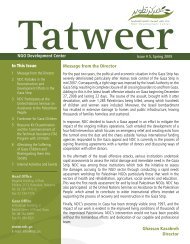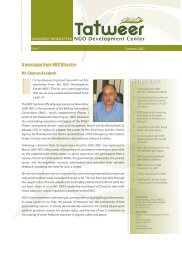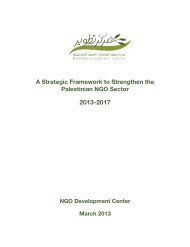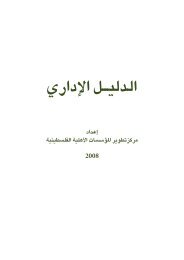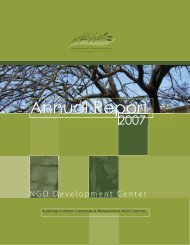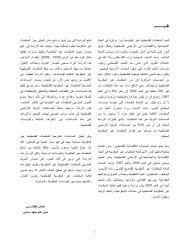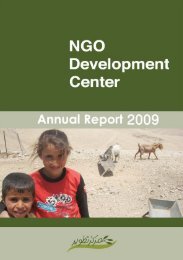Tracking External Donor Funding.pdf - NDC
Tracking External Donor Funding.pdf - NDC
Tracking External Donor Funding.pdf - NDC
You also want an ePaper? Increase the reach of your titles
YUMPU automatically turns print PDFs into web optimized ePapers that Google loves.
International Non-Governmental Organizations are an important conduit of international aid into the WB&GS –<br />
they are also the least understood. These organizations receive both bi-lateral and multi-lateral funds, as well as<br />
donations from various constituencies that are used for their own project implementation or partnership with<br />
implementing PNGOs.<br />
Types of NGOs<br />
New Organizations (Vocational Centers) were formed at the end of the seventies and beginning of the eighties and<br />
adopted new methods of administration to tackle issues previously left unattended by the main Palestinian players. Such<br />
organizations depend on a specialized professional staff for both their structure and function and include full-time, parttime,<br />
and voluntary workers. Usually, their authoritative bodies are composed of a small number of interested people<br />
who agree on the objectives of the organization and its message.<br />
Traditional Organizations use less rigidly structured administrative methods in their work. Their interests usually<br />
include charity work and activities related to local society, such as youth clubs and charitable institutions.<br />
Development Organizations aim to generate a long-lasting impact on Palestinian society through sustainable projects<br />
and programs, not by addressing the immediate needs of the population.<br />
Relief Organizations are those whose programs aim at providing for immediate social needs, such as food, shelter,<br />
housing, health and other services. These organization typically act in reaction to a event or crisis in the short term and<br />
forego longer term development activities.<br />
Aid Types<br />
International flowing into the WB&GS is generally broken down into three types: PA Budget Support, Emergency Aid<br />
and Development Assistance.<br />
Budget Support includes all contributions to PNA institutions, and since 2006, to the Temporary International<br />
Mechanism (TIM) and the ESSP, as well as any aid going directly to the Ministry of Finance to cover the government's<br />
recurrent costs. It also includes payments of the PNA recurrent costs, such as fuel. Significantly, this does not include<br />
support for specific ministries running specific programs—these are largely classified under development assistance (ie.<br />
The Ministry of Health) (MoP, 2008:10).<br />
Emergency Aid: Includes all funding to UNRWA and other humanitarian organizations, all funding which is directly<br />
responding to the conflict such as rebuilding destroyed infrastructure or mitigating the effects of the Wall or closures,<br />
any short-term employment generation/ job creation activities, all food aid, all work directed at refugee camps, all work<br />
addressing crossing points, psychosocial/trauma programs, Quartet activities, support to Palestinians in Israeli detention,<br />
Avian flu-related activities, any funds channeled through the Consolidated Appeals Process, and conflict/humanitarian<br />
monitoring activities (ibid).<br />
Development Aid: Includes everything which does not fall in the first two categories, including "peacebuilding"<br />
activities. The broad definition of development, and its overlap into by other sectors, is reflective of the wide variety of<br />
organizations that fall under this banner. This is the primary type of aid flowing to the PNGO sector and the least<br />
understood by planners.<br />
Local Partners<br />
Though our study does not distinguish between NGOs and CBOs, there is a noticeable and growing difference between<br />
the two.<br />
NGOs (PNGOs) are the larger, well-established organizations that have grown more and more dependant and adept to<br />
the international aid system. These organizations have administrative capacity, infrastructure and organized governance.<br />
While nearly all of them are engaged in direct project implementation, large PNGOs, much like the INGOs, now often<br />
partner with smaller organizations known as CBOs.<br />
CBOs are often better described as ‘ad-hoc’ organizations that form around a single project or idea before melting back<br />
into society. They usually lack the same structures, hierarchies and expertise as larger NGOs, and as such, are unable to<br />
access international funding in the same way.<br />
81


